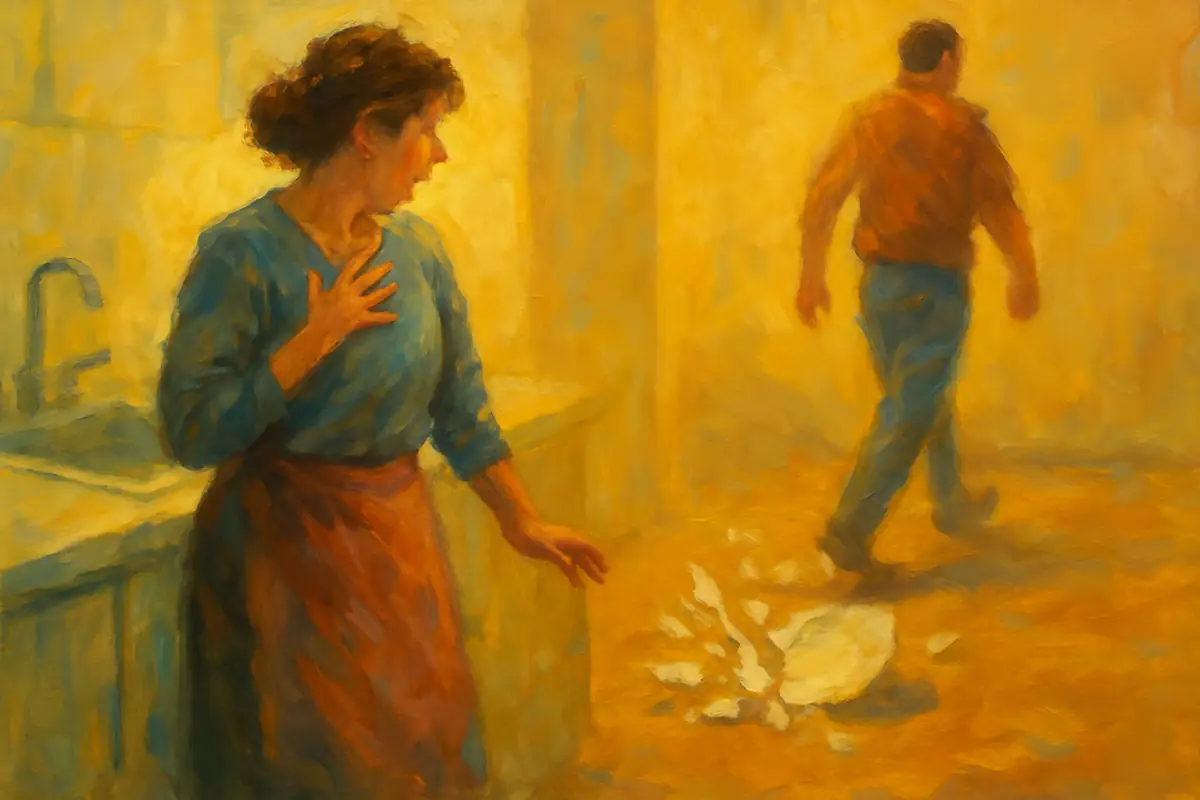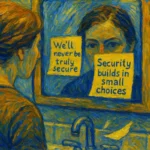A Gentle Tapping Script for Processing a Painful Memory
Integrating the Somatic Wisdom of Peter Levine, PhD
Honoring the Body While Healing the Past
Part One — The Jolt
It happened in the break room on an ordinary Tuesday. Lena was rinsing her mug when someone tried to drop a ceramic plate into the sink beside her. It missed and crashed to the floor. The clang against the tiles was sharp — not dangerous, not even loud enough to make anyone else react — but her body stiffened instantly.
Her shoulders shot up to her ears, her breath locked tight in her chest, her heart thudded hard and fast. She laughed it off, muttered something about being “jumpy,” but even an hour later at her desk, her fingers trembled over the keyboard.
At home that night, she searched why am I so jumpy for no reason. She skimmed articles about stress, anxiety, and the nervous system. One short post caught her eye — “tapping” or EFT, a way to help the body calm down. It described tapping on acupressure points while repeating a statement, and how some people paired it with awareness of physical sensations.
She didn’t really believe it would work. But she liked the idea of calming her body without caffeine, sugar, or wine. She decided to try it — just once.
Part Two — The First Session
Lena sat cross-legged on the couch, blanket over her lap, phone open to a beginner’s guide. The instructions were simple: identify a problem, rate the discomfort (SUDs) from 0–10, say a setup statement three times while tapping on the side of the hand, tap through eight points saying a short reminder phrase, and then re-rate the discomfort.
She picked the tightness in her shoulders and chest. SUDs: 7.
Side of hand: “Even though my shoulders are tense and my chest feels tight, I accept myself.” (x3)
Points: Tense shoulders… Tense shoulders… all the way through.
She paused, breathing. SUDs: 5. Not bad. She felt silly, but a little looser. She stopped there.
Part Three — One Week Later
It was a squeaky grocery cart this time — a high-pitched squeal behind her that made her grip her own cart like a life raft. At home, she went to the couch again. This time, she named the feeling: tight, buzzing, ready to bolt. SUDs: 8.
Side of hand: “Even though my chest is tight and I want to get away, I accept myself.” (x3)
Points: Tight chest… Tight chest…
Halfway in, an image appeared: a chipped blue, faded paint. Her chest pulled in harder. She kept going, adding a second round with the same phrase. By the third round, the tightness had eased. SUDs: 8 → 3. She decided she’d keep tapping from now on until she got it to 3 or below.
Part Four — Ten Days Later
Midway through tapping on “tight chest,” the blue returned — and this time, a sound: leather scraping across wood. Her throat felt smaller. She pressed her feet into the couch cushions, felt the fabric under her toes.
Round one: Tight throat. SUDs: 7.
Round two: Tight throat. SUDs: 5.
Round three: Tight throat. SUDs: 3.
The sound faded, but the blue stayed.
Part Four-and-a-Half — In Between
In the days after, Lena tapped on other things — a fight with her sister, the stress of a looming work deadline, the headache from staring at a screen too long. She started watching short videos from more experienced tappers. They didn’t just repeat the same phrase — they added whatever came to mind: sensations, emotions, even little flashes of memory. She liked the way it felt less mechanical, more like a conversation with herself.
She also came across an interview with a trauma therapist, Peter Levine. He talked about “pendulation” — moving attention back and forth between a difficult sensation and a safe one. She decided to try that the next time the blue door showed up.
Part Five — Three Weeks Later
The blue spread into a door — wooden, flaking paint, a black iron handle. And just at the edge of sight: brown leather shoes, scuffed at the toes. Her stomach turned. She noticed her jaw clench and decided to name both.
Side of hand: “Even though my stomach is tight and my jaw is clenching, I accept myself.” (x3)
First round: Tight stomach and clenched jaw.
Second round: This door I don’t know.
Third round: The shoes at the edge of my sight.
SUDs: 7 → 3. The shoes stayed, but her breath was steady.
Part Six — One Month Later
The door. The shoes. The scrape. And now a voice — muffled but sharp, rising. She saw the handle above her, too high to reach. Her breath quickened. She tapped, remembering Levine’s advice.
Setup: “Even though my breath is fast and my chest feels tight, I’m here now.”
“Even though this feels close, I can touch the blanket and know it’s today.”
Eyebrow: Fast breath.
Side of Eye: The handle out of reach.
Under Eye: I’m small here.
Under Nose: The blanket is warm.
Chin: This voice is in the past.
Collarbone: I survived.
Under Arm: I’m here now.
Top of Head: I’m safe enough now.
Second round, she added: I can move between then and now… my breath belongs to now. SUDs: 8 → 3.
Part Seven — Six Weeks Later
The door opened into a small porch. Damp wood. Wet iron railings. Voices tangled somewhere inside. Her pulse quickened. She pressed her feet into the couch, felt the blanket’s weight.
Side of hand: “Even though my heart is racing, I’m here with it.”
“Even though I don’t know the whole story yet, I can let it come slowly.”
Eyebrow: Racing heart.
Side of Eye: The smell of wet wood.
Under Eye: The sound of voices I can’t quite hear.
Under Nose: I’m holding the blanket.
Chin: My feet are pressed into the couch.
Collarbone: I can let this porch fade.
Under Arm: I am safe here.
Top of Head: I am safe now.
Second round: My breath belongs to today… I can let the present hold me. SUDs: 7 → 2.
Part Eight — Two Months Later
The scene sharpened: she was on the porch, back to the blue door, knees pulled in, the brown shoes approaching from inside. Her body froze. She tapped slowly.
Side of hand: “Even though I feel frozen, I’m here.”
“Even though I couldn’t move then, I can move now.”
Eyebrow: Frozen body.
Side of Eye: The shoes coming closer.
Under Eye: The smell of rain.
Under Nose: I want to run, but I stay.
Chin: I can breathe here.
Collarbone: I can loosen my shoulders.
Under Arm: I am my own safety.
Top of Head: I am my own.
Second round: I can feel my feet now… I can let this pass. SUDs: 9 → 3.
Part Nine — The Memory Returns
It was late when the last piece came. The door. The porch. The shoes. And then — clarity. She was five. They’d lived in that house only another year before moving away. She hadn’t thought about it since, hadn’t remembered the door until now.
Her brother — fifteen, tall and strong in her eyes — had walked home from school with friends. Three older boys followed. Voices turned sharp. One shoved her brother. Then another. Then fists. She had pressed herself against the blue door, too small to reach the handle, too scared to move. Couldn’t yell. Couldn’t run for help. She watched him hit the ground. The kicks came, one after another.
Her body had locked. She’d felt heat in her face from holding back tears. And then… nothing. She’d shut it away. Now, decades later, her hands shook as she tapped.
Side of hand: “Even though I felt powerless and froze, I accept myself.”
“Even though I thought I was a coward, I was just a child.”
Eyebrow: Powerless.
Side of Eye: I couldn’t help him.
Under Eye: I thought I was disloyal.
Under Nose: I was just a little girl.
Chin: It wasn’t my fault.
Collarbone: I survived.
Under Arm: I’m here now.
Top of Head: I’m safe now.
Second round: I can let my body release this… I can breathe again… I can feel my feet here on the floor. SUDs: 10 → 2. Tears came, hot and unforced. She stayed until her breath was steady.
Part Ten — After
In the weeks that followed, she noticed the difference. A loud noise behind her no longer made her jump. She could see a door that color and keep walking. She could think of her brother without the old wave of shame.
Epilogue — The Realization
She used to think healing was for other people — people with real trauma. She didn’t see herself in that word. Not until her body showed her what it had been carrying for decades. Now she thought maybe trauma wasn’t rare at all. Maybe it was just the name for the ways we lose connection to ourselves when life overwhelms us. And maybe healing is the slow return.
Later, she found a quote from Peter Levine: “Trauma is about loss of connection — to ourselves, to our bodies, to others… Restoring this connection is restoring well-being.”
Outside, the air smelled faintly of earth warming after winter. She closed her eyes, listening to the birdcall somewhere above, and thought: this is connection.



